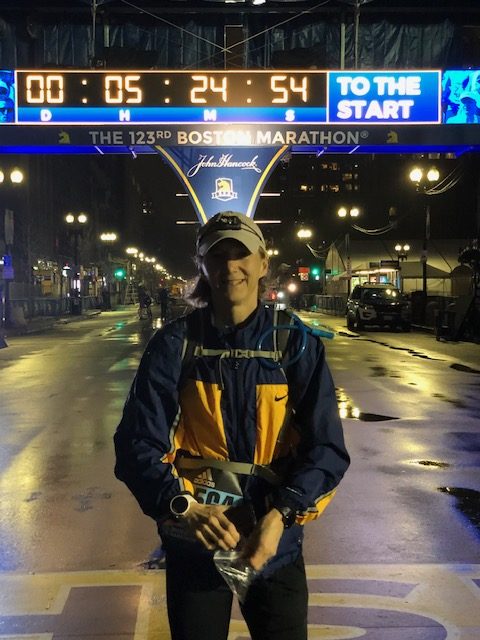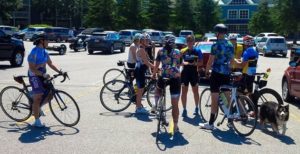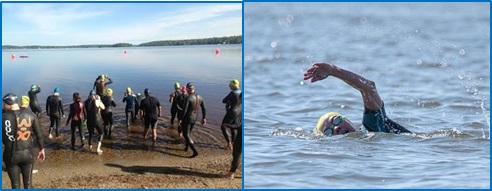One of the most iconic races in the world is the Boston marathon. Famous for its history, hills and heroes, Boston is one race that runners around the world aspire to. The experience itself is extraordinary with traditions that transcend generations, many of which are known only to the insiders who have made the journey from the crowded school yard in Hopkinton to the final turn on to Boylston and across the famous finish line.
Andrea Cameron is one of those insiders who has earned her spot and crossed that finish line 11 times. Going back this year for #12, she set a new challenge for herself – the Double Boston. While it’s not officially sanctioned, it’s definitely a ‘thing’. Over the past decade more than a handful of runners have taken on the challenge of starting at the finish line in the pre-dawn hours to run out to the race start, then turn around and run back in the official race. That’s 84.2km (or 52.4miles) of hills – up and down – no matter how you look at it.
Why? Andrea remembers reading about the Boston Double a few years ago and thought to herself, “Those guys are crazy!” A few years later, and a 62k ultra trail race under her belt, her thoughts turned to “Why not? It would be a great experience.” Although Andrea is an experienced runner and has had very little time off due to injury since she began distance running in 1992, she decided that taking on this challenge might require a training plan to ensure her success. She returned to CL Performance Training after her successful experience training for a 50 mile ultra in 2013.
Training for the double marathon required some strength training early in the program to ensure she was strong enough to handle the volume. Some days included a long run, then a second run to become accustomed to running on tired legs. Andrea saw the tempo runs as challenges, but decided just to try and see what she could do – sometimes surprising herself. Throughout the training, it was important for her to remain body aware to avoid over training injury or break down.

At 4:36am on race morning, Andrea started from the finish line in Boston and began to make her way through the isolated and dark streets with a headlamp, hydration pack, and the company of her husband for the first hour. This was now one of the best moments to make all the training worth it: getting the chance to run DOWN the famous Heartbreak Hill. After that, she was truly on her own – (four runners had started off five minutes ahead of her at a faster pace and two guys would pass her along the way; one so deep in his zone that he didn’t even acknowledge her presence.) The peacefulness of the streets was meditative, interrupted only by the downpour of a thunderstorm, creating puddles that finished the job of soaking her shoes. She stopped only to peel off the early morning jacket and tights as the day warmed up, and to try adjusting her hydration pack. Unfortunately, the pack was stuffed too tightly with a change of clothes for the second marathon, which prevented the flow. (Forgot to test before the start!) Salvaging the water by transferring several times to a small bottle, a new source was needed by mile 18. Despite water stations now appearing every mile with volunteers diligently setting up, her first request was denied – they weren’t quite ready – and somewhat surprised to have a runner coming from the opposite direction.

As the towns flowed by, waking up for race day, with hundreds of volunteers setting up the aid stations, Andrea’s left hip began to complain. It was a distraction, but a familiar pain that she knew she could push through. Coming up on the gathering spectators who were turned toward the direction of the race in anticipation of the wheelchair athletes who are first to start, she would get a surprised “Where did you come from?!” It was an even more surprised response to her reply. “Boston?!”
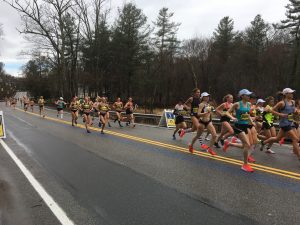
Closing in on the last mile, Andrea had a rare and unique view of the elite women and men’s races as they got under way. After making her way through the security check (which included having to discard her pack), Andrea found a surprisingly ‘fresh’ portalet in which to change her clothes, and then went about preparing for her designated wave 3 start 50 minutes later. This included taking care of her feet with Vaseline and dry socks, gobbling down two Cliff bars and enjoying the view of wave 1 and 2 runners heading off to Boston on their personal journeys. Her plan was to run the second marathon as if it were a fresh start, and not think about the total mileage for the day.
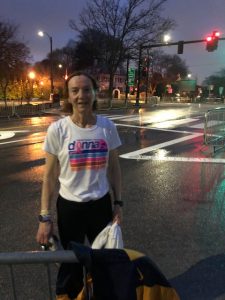
It was a good plan, but shortly out of the start, her right knee started to act up, keeping the pace slow. It was mentally hard being passed by so many people at the beginning, but she decided to just push through it, and by mile 12 the endorphins had taken over and she was able to approach her usual pace. The cheering of the crowds and high fives with the kids was a huge boost. When things got tough, she reminded herself of the kids she had raised money for and felt grateful that she was able to be a runner in the first place. (Andrea initiated a fund raising campaign for the Youth Assisting Youth peer mentoring program for at risk youth in the Toronto and York region. Donations from friends and family, and matched by her and her husband, totaled more than $4,600.00!)
Andrea managed to run a negative split…between the two marathons. (The first marathon took 5:05 including the stops for shedding clothing, pack issues and photos of the elite and wheelchair athletes; the second official time was 4:31:49 including a washroom break.) The sun had come out by mid-day to really heat things up along the way, then the rain and cold wind started in the final miles, making a roller coaster ride of hills and weather.
Andrea crossed the finish line thinking “I am so happy to have completed this. Hmmm, but if there is another Boston for me, well, I will look forward to the bus ride to the Start!” and hobbled off to the hotel for a cold beer and a warm reunion with her husband, then off to a big dinner with a close family friend from Boston. By next day, the pain in her hip and knee returned, and for the next few days, she felt like she was walking on stilts, and was grateful she wouldn’t be doing any running for a few days, at least.
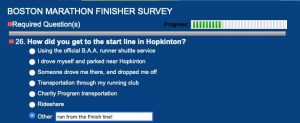
Would she do it again? Asked that question a few days later, she thought that she might be convinced if someone were to get excited about running it together. So, what’s next? Andrea lights up at the idea of doing Comrades in the next few years, but is turning her attention to the Ottawa race weekend in May, and another 62km trail race with her son this September.
For a runner whose body seems to like the long distances – why not?
- Sandie Orlando is an age group triathlete who writes about her own experiences, and those of other age group athletes, to discover the ‘why?’ behind their mutual need to continue training for and racing endurance events. Her mother still can’t understand it! To read more about The Adventures of Sandie and Spike, visit www.sandieandspike.blogspot.com
